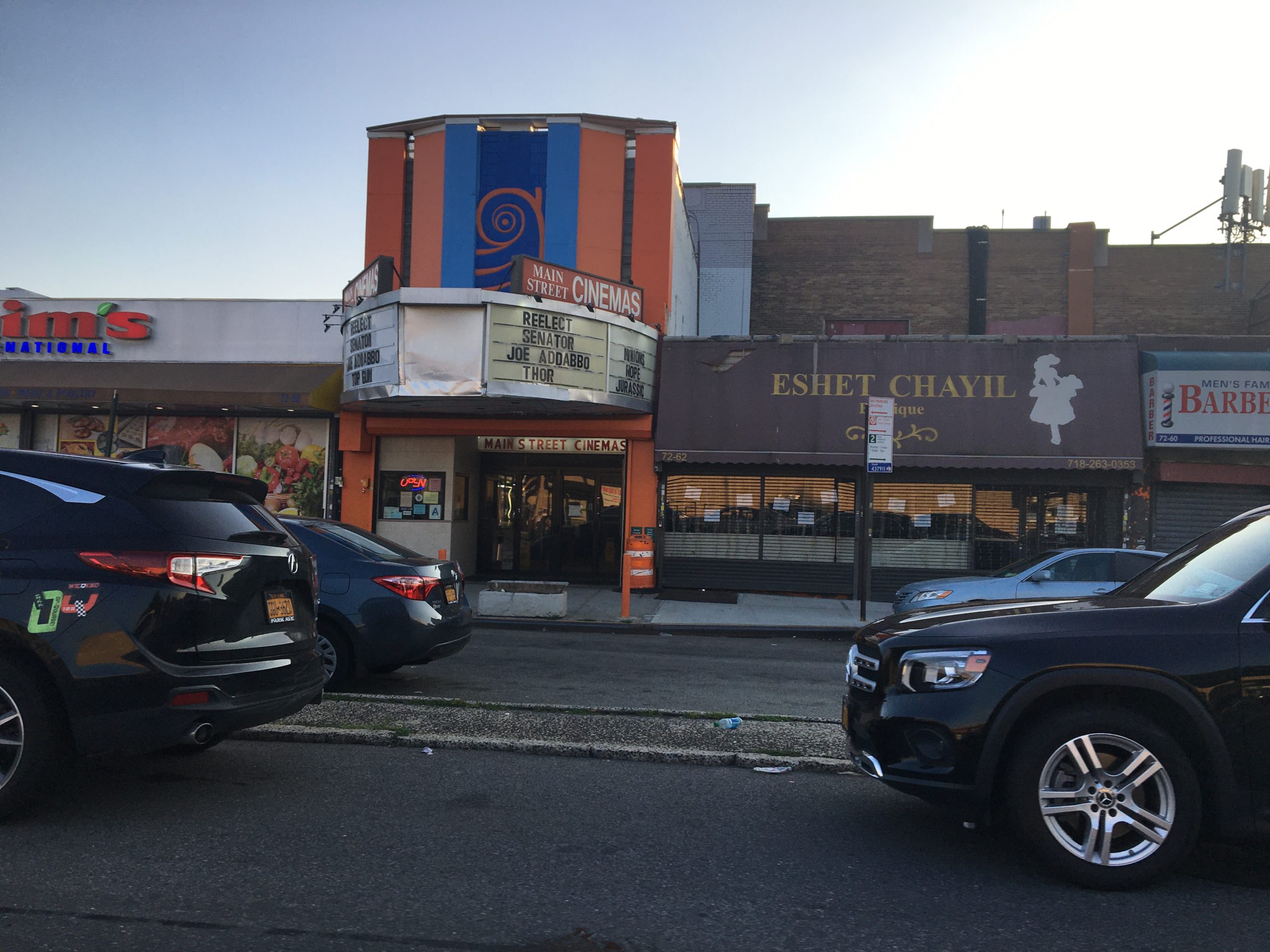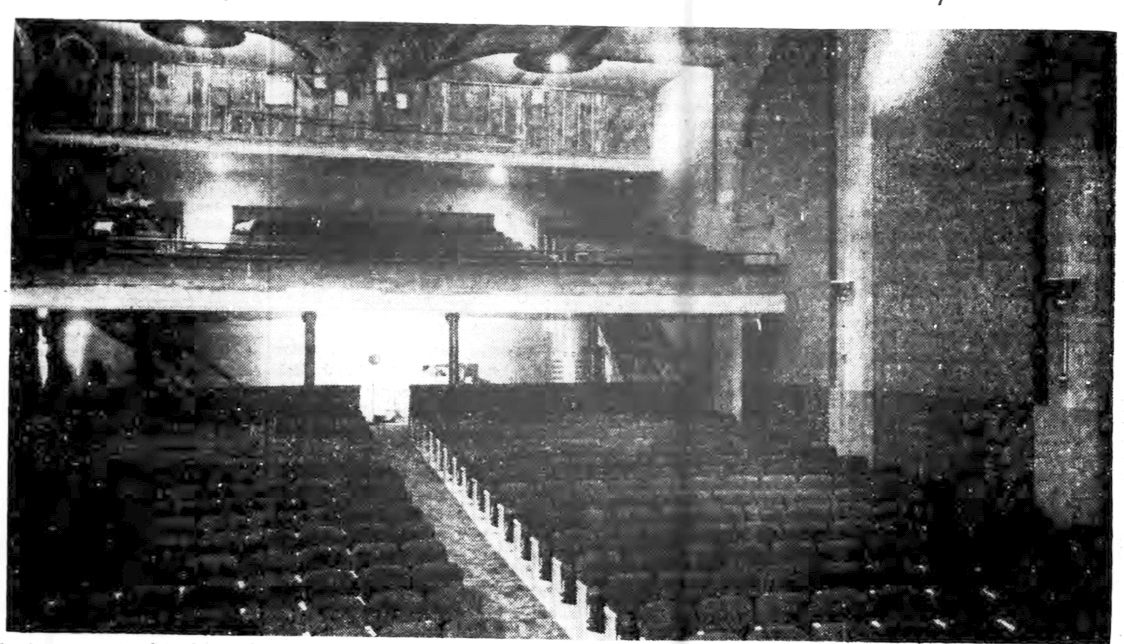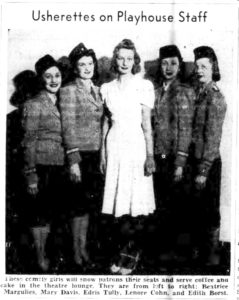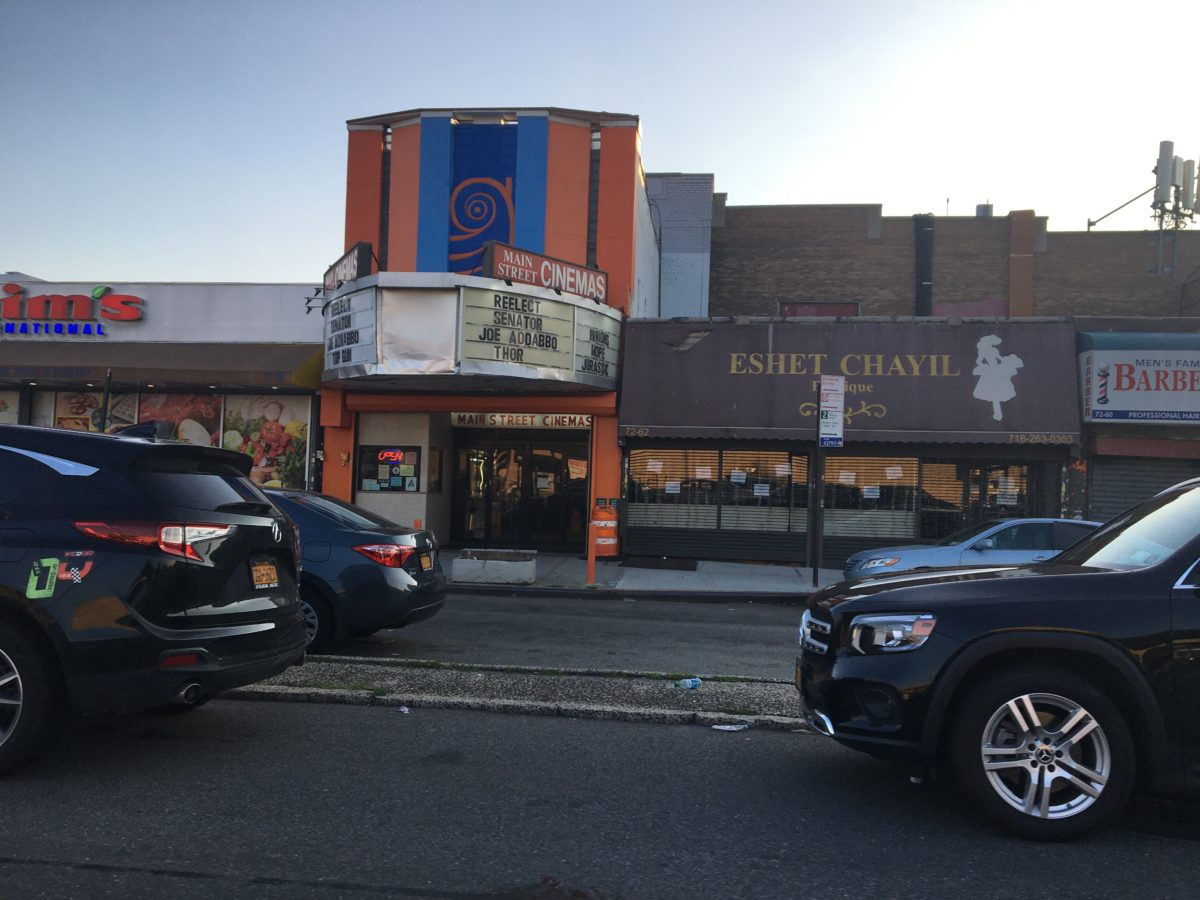Perlman: Curtain Call for Main Street Cinemas
Local theater shutters after 80 years
By Michael Perlman
mperlman@queensledger.com

Main Street Cinemas. (Photo: Michael Perlman)
Upon hearing that Main Street Cinemas at 72-66 Main Street in Kew Gardens Hills will close its doors on Labor Day weekend, audiences of past and current local residents are already mourning its loss.
The $75,000 movie theater opened as a single-screen venue on January 29, 1941 as the Main Street Playhouse.
It was designed by Queens’ own architect Joseph Unger (1896 – 1996), who also designed the 1939 World’s Fair-inspired Trylon Theater in Forest Hills.
Now a six-screen, 550-seat venue, the independently operated Main Street Cinemas screens first-run films.
The Art Deco angular stone façade with vertical glass block bands was recently rediscovered after being concealed for decades, and it received a South Beach-inspired color scheme.
It is currently unannounced as to why Main Street Cinemas is closing its doors, but besides pandemic-related losses, rumors include a property sale and a higher rent.
Some residents suspect that it will be converted into a catering hall, synagogue or mini mall, while many hope that it will undergo a restoration as a theater.
Throughout much of the 20th century and into the 21st century, most neighborhoods citywide had at least one movie theater, which granted its distinction and harbored a sense of community, while bonding generations in an inviting ambiance with a diverse film selection.
In relatively recent times, single screens were converted into multiplexes, but with DVDs, rent increases, Movies On Demand and Netflix, theater chains and independent operators must engage in proactive and creative planning to stay afloat.
Flashing back to 1941, the United L.I. Theatres Company also included the Trylon, St. Albans, Laurelton, Island, Cambria and the Linden, and was advertised as “Long Island’s most progressive theatre group.”
Main Street Playhouse’s grand opening featured “Escape” starring Norma Shearer and Robert Taylor, screened from the self-titled bestseller by Ethel Vance, in addition to featuring “Wyoming” starring Wallace Beery.
In 1948, it was operated by Interboro Circuit, Inc. and became independently operated in the late 1970s. In 1985 the theater was twinned, followed by being quaded and sixplexed in 1998.
On the day of its grand opening in 1941, readers of the Long Island Daily Press learned that the “Main Street Playhouse is equipped with every up-to-the-minute improvement to make it one of the finest in the city.”

Main Street Playhouse auditorium, 1941.
The original seating capacity featured 450 seats on the main floor and 150 in the loge. The lighting system was considered to be a chief feature.
It read, “Indirect, fluorescent lights designed to eliminate eye strain have been installed throughout the theatre. These lights, first introduced at the (1939) World’s Fair, shed a soft glow from tubing concealed in cloves and in the dome of the auditorium, making for beauty an effectiveness.”
Fluorescent carpeting covered the auditorium and illuminated in the dark, and patrons sat comfortably in deep cushioned chairs in rows spaced at 34 inches apart, rather than the customary 30.
Pabst air conditioning and innovative artesian wells cooling the air in the summer contributed to comfort.
A versatile experience was a guarantee. “The inside of the building is decorated in a modernistic style, with an emphasis on the club lounge fitted out for the added comfort of patrons —even to the serving of coffee and cookies,” readers learned.
The theater was the destination of Kew Gardens Hills, which was a new neighborhood consisting of garden apartments, rowhouses and mom and pop shops, and its proximity to Flushing Meadows was an asset. It read, “The new Main Street Playhouse is readily accessible from all parts of Queens and western Nassau counties.”
Irving J. Stein was a well-respected manager, and a team of usherettes included Beatrice Margulies, Mary Davis, matron Edris Tully, Lenore Cohn, Edith Borst, Katherine Cardello, Stella Purdoski and Pauline Emanuel. The publication read, “All have been well-schooled in the motto of the Main Street Playhouse – ‘Always at Your Service.’”

Main Street Playhouse staff, 1941.
A changing theater program on Wednesdays and Sundays was the management’s policy. It stated, “There will be a careful selection of pictures with special attention given to films for children to conform with standards set up by child welfare organizations.”
Four days after the grand opening was a Technicolor film Sunday featuring “The Thief of Bagdad” starring Conrad Veidt, John Justin, June Duprez and Rex Ingram.
Fast-forwarding to the present, patrons reminisce and express many sentiments.
“Its closing will be a loss to the old neighborhood,” said Moshav Zippori, Israel resident Mitch Pilcer, whose family lived in Kew Gardens Hills for 50 years and he relocated a few years ago after his parents passed away.
He reminisced, “Main Street was the center of our world when we were kids and the movie theater was where us kids hung out. I remember when Batman and Robin showed up in the Batmobile when the ‘Batman’ movie opened in the 1960s. We would wait on long lines when they had features for kids on weekends.”
“It’s been here forever, and I’m upset that it’s closing,” said Danny Heisler of Kew Gardens. “Let’s find a way to make it a historical landmark, which can likely be made one with a politician’s help. I have memories of superhero and ‘Star Wars’ movies. We would save money by going to the matinee.”
Hollis Hills resident Sharon Moriber was raised in Kew Gardens Hills in the 1980s. She explained how the theater holds tradition for many.
“My parents took me to the movies on Main Street, and then as a teenager, my friends and I saw countless movies from ‘Dirty Dancing’ to ‘Top Gun.’ We could walk there and get something to eat next door. I also had my first date in college there, and now my children enjoy it too. It’s an iconic place and I’m sad it’s closing. I can’t imagine anything else being there.”
She asked, “Why are they closing it? Do they need a fundraiser?”
“I’m very sorry to see a neighborhood staple going away,” said Rhoda Dubin of Kew Gardens Hills, who’s been a Queens resident since her marriage in 1981.
“It really was nice for my husband Mark and I to be able to walk there so close to home. We would also go for ice cream very close by. These are special memories, since I’m a widow now.”
Eyeing the future, Kenneth Stiefel of Kew Gardens Hills, said “I am up for a dinner theater, but in this neighborhood, they would have to offer kosher food.” He recalls consistently patronizing the theater as a child.
“They were cheap, so it was a great outing for a couple of friends to go on a Sunday. I saw ‘Toy Story 2’ with my mom and ‘Toy Story’ with my friend. My friend and I would see horror movies there recently. We saw ‘Lego Movie 2’ and they restarted it when we got there five minutes late. I also remember waiting in line in the cold to see ‘Rugrats in Paris’ with my dad and sister.”
When Kew Gardens Hills resident Meira E. Schneider-Atik sees the theater, she mostly has recollections of dates with her husband prior to and during their marriage.
“We had our first movie date there and saw ‘Shrek.’ During our Shanah Rishonah, I missed the Oscars telecast so that we could see ‘The Pianist.’ I also insisted that my husband see the second ‘Harry Potter’ movie with me and the live-action ‘Beauty and the Beast.’” She continued, “I can’t remember this neighborhood without this landmark.” Hoping for its revival, she said, “Perhaps if it’s serviced in any way needed, it might draw people.”
Examining its current status, Fresh Meadows resident Zayde Joe said, “Sadly, some people in the neighborhood don’t really care.” In the interim, she said, “Perhaps they can convert it to a temporary shul for Rabbi Friedman.”
If Main Street Cinemas underwent restoration to reveal its outstanding Art Deco interior features and became a mixed-use movie/dinner theater with performance opportunities, the theater could once again raise its curtains and become a versatile, large-scale draw for the immediate and Queenswide community.


